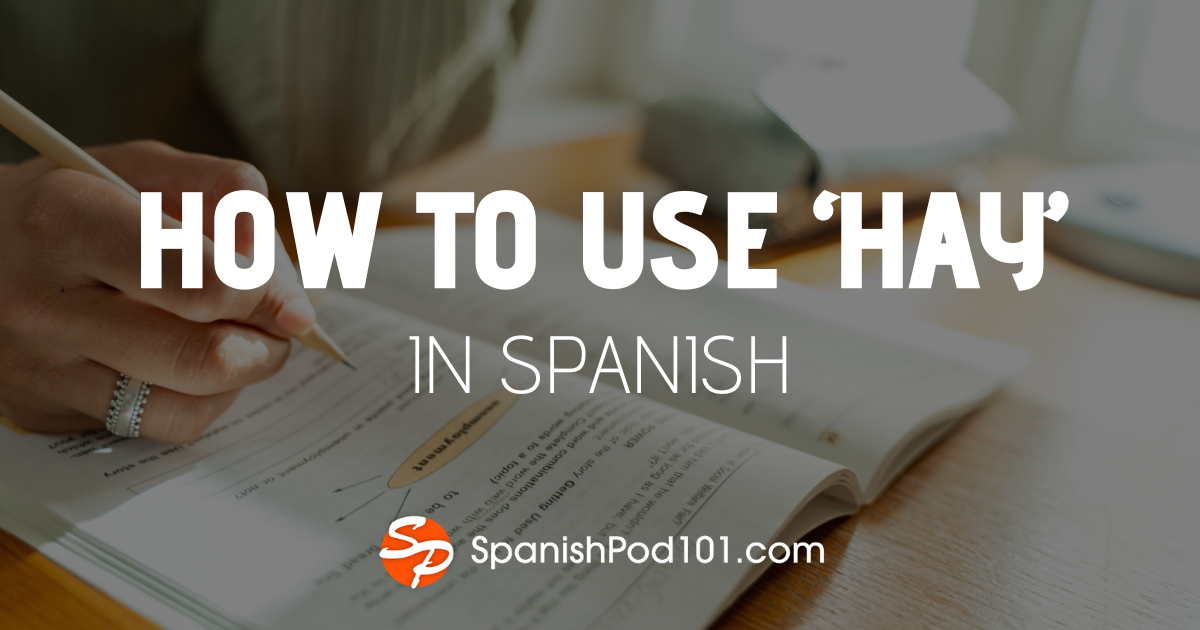
One of the most common Spanish words you’ll encounter is “hay.” This little word appears everywhere in conversation and prompts many beginners to ask: “what does hay mean in Spanish?”
In short, hay in Spanish means “there is” or “there are”. An essential term in everyday Spanish, used to express the existence or presence of something. In this article, we’ll explore the meaning of hay, its conjugations, and when to use hay instead of other words.
What Does “Hay” Mean in Spanish?
In Spanish, hay is an impersonal verb form that indicates existence. Hay comes from the verb haber, and is used only in the third person singular (it doesn’t change with plural). The meaning of hay in Spanish is “there is” (for singular things) or “there are” (for plural things).
Importantly, hay never changes form based on number – it stays hay whether you’re discussing one item or many. For example: “Hay un libro en la mesa” and “Hay tres libros en la mesa.” In both cases, we use hay to acknowledge the existence of the book(s), despite one being singular and the other plural.

Being an impersonal expression, hay doesn’t have a specific subject. It simply tells that something exists or is present. This makes it incredibly useful for beginners and travelers. People use it to identify things around them or to ask about the presence of something.
Think of hay as the Spanish equivalent of saying “there is/are” in general statements. It can introduce new information or general facts.
For instance, “Hay muchas playas bonitas en México” translates to “There are many beautiful beaches in Mexico.” The Spanish “hay” here signals that those beaches exist, without specifying any one in particular.
Using “Hay” in Sentences (Statements & Questions)
Because hay means “there is/there are,” you will use it in all kinds of sentences describing what exists. It works the same in written and spoken Spanish.
To make a statement, simply put hay before the item: e.g., “Hay un museo en esta ciudad” (“There is a museum in this city”). To form a negative statement, add no before hay. For example: “No hay escuela hoy” means “There is no school today.”
A widespread phrase you might hear in Mexico is “No hay problema,” which translates to “No problem” (literally, “There is no problem”). In all these cases, hay stays the same regardless of whether the noun following it is singular or plural.
Asking questions with hay is straightforward. You simply use hay with question intonation or punctuation to ask “Is there…?” or “Are there…?”. For example, “¿Hay un cajero automático cerca?” means “Is there an ATM nearby?” The word order doesn’t change – just your tone or the question marks signal that it’s a question.
You can also ask questions like “¿Hay turistas allá? (Are there tourists there)?”
To answer, use hay in your response. If the answer is yes, you might say “Sí, hay uno” (“Yes, there is one”). If there is not, you say “No, no hay” (“No, there aren’t any”).

Notice that in a negative answer, we use two no’s. The first no means “no,” the second carries the meaning of the “not” in “isn’t.” This simple Q&A pattern – “¿Hay…?” / “Sí, hay…” / “No, no hay…” – is extremely useful for travelers.
Conjugation of “Hay” (Present, Past, and Future)
Hay is actually the present tense form of the verb haber in its impersonal usage. While hay covers “there is/are” in the present, you may wonder about other tenses.
To conjugate haber for these meanings (often informally called the “hay” conjugation), Spanish uses different forms. In the past tense, there are two common forms: había and hubo, both meaning “there was/there were”.
“Había mucha gente en la fiesta” (“There were many people at the party”) uses había to describe a general situation that happened. “Hubo un accidente en la calle” (“There was an accident on the street”) uses hubo for a specific past event. So, both había and hubo mean that something existed in the past, but había is more descriptive (imperfect tense) and hubo is more event-focused (preterite tense).
In the future tense, hay changes to habrá, which means “there will be”. This form is useful for talking about upcoming events or expectations. For instance, “Habrá un festival mañana” means “There will be a festival tomorrow.” If you need to say “there would be” (conditional), you use habría: “Habría más tiempo si llegaras temprano” (“There would be more time if you arrived early”).
These conjugations are all derived from haber and remain impersonal (they don’t change for gender or number). Even in plural situations, you do not add an -n to these forms – for example, “there will be many people” is “habrá muchas personas,” not habrán (a common mistake to avoid). The future tense of hay is always habrá (never hayrá or habrán) .
Likewise, “there were” in Spanish is expressed with había or hubo (not habían for a plural noun). The rule is consistent: the impersonal forms of haber stay in the singular because they express “there is/are” as a general idea, not a specific subject.
Using “Hay” vs. Other Spanish Verbs (Estar, Tener, etc.)
New learners sometimes wonder when to use hay instead of other verbs, such as estar or tener. The key is that hay talks about the existence of something, while verbs like estar talk about the location or state of a known thing.
For example, if you walk into a building looking for a restroom, you might ask “¿Hay un baño aquí?” (“Is there a bathroom here?”) to find out if one exists. Once someone says yes (Sí, hay uno), you would then ask ¿Dónde está el baño? (“Where is the bathroom?”) to locate that specific bathroom.
This simple scenario shows the difference: use hay to ask or say there is/are in general, but use está/están (from estar, “to be”) to talk about where a particular thing is.
In grammar terms, hay is typically used with indefinite nouns or unknown items (un/una, muchos, etc.), while estar is used with definite or specific nouns (el/la, this, my, etc.) that you have in mind.
Another example: “Hay un restaurante cerca” means “There is a restaurant nearby” (you’re not specifying which one), whereas “El restaurante está cerca” means “The restaurant is nearby” (a particular restaurant you both know).

It’s also worth noting a couple of other distinctions to avoid confusion. “Hay” is pronounced similarly to ahí (spelled a-h-í), which means “there” as in a place (e.g., ahí está = “it’s there”).
Another common verb is tener (“to have”), but you wouldn’t use tener to say “there is.” For example, in English you might say “the hotel has a pool,” but in Spanish it’s often more natural to say “Hay una alberca en el hotel” rather than “El hotel tiene una alberca.”
Lastly, despite looking like the English word “hay,” the Spanish word “hay” is completely unrelated. If you’re wondering how to say horse hay in Spanish, the word for animal hay (dried grass) is heno.
As you continue learning Spanish, keep practicing hay in everyday questions and statements. You’ll hear it often in phrases like “¿Qué hay?” (“What’s there?” or casually “What’s up?”) and “No hay de qué,” a polite response to gracias meaning “You’re welcome” (literally “there’s nothing to it”).
Conclusion
In conclusion, hay is a small but incredibly useful word in Spanish that every beginner should master. It enables you to talk about the existence of anything — from amenities in a hotel to sights in a city — with one simple term.
By understanding the meaning of hay in Spanish and how it differs from verbs like estar, you can avoid common mistakes and communicate clearly. It’s a fundamental part of Spanish that opens the door to describing the world around you. ¡No hay duda que practicar hay te ayudará mucho en tu viaje!








